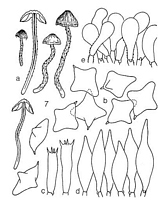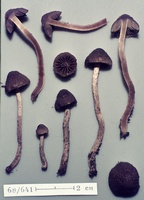|
 Crucispora naucorioides Crucispora naucorioides
BiostatusPresent in region - Indigenous. Non endemic
Images (click to enlarge)
Caption: Crucispora naucorioides
Hk.: a. carpophores (nat. size). b. spores
(2000x). c. basidia (1000 x). d. cheilocystidia
(1000 x). e. cuticle (500). | 
Caption: ZT68-641, Holotype
Owner: E. Horak: © Creative Commons Attribution-Noncommercial 3.0 New Zealand |
Article: Horak, E. (1971). Contributions to the knowledge of the Agaricales s.l. (Fungi) of New Zealand. New Zealand Journal of Botany 9(3): 463-493 (http://www.rsnz.org/publish/abstracts.php).
Description: Pileus 5-30 mm diam., hemispherical or conical
when young, later convex or campanulate; deep brown, tobacco brown or clay coloured;
distinctly grooved or wrinkled, radially veined, dry, hygrophanous: with scattered,
fibrillose remnants of the veil along the non striate margin. Lamellae (L 10-15,
13) adnate or adnexed, ventricose: beige, later becoming clay or buff brown
with white, fimbriate gill edge. Stipe 20-60 x 2-4 mm, cylindrical, fistulose,
single: whitish or concolourous with pileus, covered with darker dots and squamules
of the veil remnants, permanent cortina or ring absent; dry, apically pruinose.
Context not gelatinous, brownish. Smell and taste not distinctive. Chemical
reactions on pileus: KOH— negative.
Spore print brown. Spores 12-15 x 11-14 µm,
cruciform, rhomboid (like the spores of Pterospora Metrod 1949), smooth, thin-walled,
yellow-brown, germ pore absent. Basidia 13-20 x 8 µm. 4-spored. Cheilocystidia
(and caulocystidia) 40-50 x 10-14 µm, fusoid, thin-walled, hyaline, without
crystals, forming a sterile zone at the gill edge. Cuticle an hymeniderm consisting
of clavate cells (25-40 x 8-15 µm), membrane not gelatinised, strongly encrusted
with brown pigment, clamp connections present.
Habitat: On soil under litter of Cyathea, Phyllocladus,
and Leptospermum. New Zealand.
Notes: This unique species represents a new genus
which has no close relationships to any of the known genera of Agaricales. Furthermore
it cannot be placed in any family recognised at the present time. The name "naucorioides"
is derived from the wrinkled pileus reminescent of the structure typical of
many species of the genus Naucoria (Fr.) Kummer 1871.
Article: Horak, E. (1980). New and remarkable Hymenomycetes from tropical forests in Indonesia (Java) and Australasia. Sydowia 33: 39-63.
Habitat: Habitat. - On soil or on rotten wood in forests (under Castanopsis-Lithocarpus-Ficus in Papua New
Guinea). - New Zealand (type), Papua New Guinea.
Notes: All macro- and microscopic characters observed on the Papua New Guinean material correspond
with those of the type. This is only just the second record of C. naucorioides so far believed to be
endemic to New Zealand. Based upon this new information it is rather likely that one day
this species is also collected in other localities within Australasia (i.e. New Caledonia,
Australia). Since the second species in Crucispora (C. rhombisperma, see below) is
known from Japan and Indonesia (Java) C. naucorioides could also be expected in
Indomalaya and/or eastern Eurasia.
|